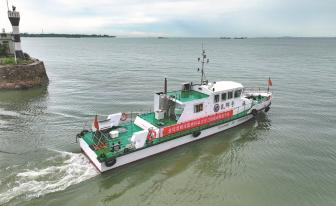China's First Ammonia-Powered Vessel Sets Sail in Anhui Province
Key Ideas
- The maiden voyage of the world's first pure ammonia-powered demonstration vessel in Anhui marks a significant step towards decarbonizing the maritime industry.
- Ammonia, a hydrogen and nitrogen compound, offers a nearly carbon-free alternative to traditional petroleum fuels, with only water and nitrogen produced upon combustion.
- Despite challenges such as safety concerns and emissions of nitrogen oxides, the ammonia-powered vessel in Hefei showcased stable combustion of pure ammonia fuel with minimal carbon dioxide emissions.
- Technological breakthroughs in plasma ignition and catalytic cracking of ammonia for hydrogen production highlight the potential for ammonia-hydrogen fuels in marine and land transport, as well as industrial applications.
The Anhui province in China witnessed a groundbreaking moment as the world's first pure ammonia-powered demonstration vessel, named Anhui, completed its maiden voyage on the Chaohu Lake in Hefei. Developed jointly by the Institute of Energy of the Hefei Comprehensive National Science Center and Shenzhen Haixu New Energy Co., this vessel represents a leap towards utilizing ammonia fuel in shipping to reduce carbon emissions. Ammonia, composed of hydrogen and nitrogen, has gained attention for its nearly carbon-free nature, with combustion resulting in only water and nitrogen. The successful voyage demonstrated stable combustion of pure ammonia fuel with minimal carbon dioxide emissions and effective control of nitrogen oxides.
The vessel, equipped with advanced technology including a high-stepped gas internal combustion generator, propulsion motors, and a twin-propeller system, has the potential to revolutionize the maritime industry's approach to fuel. The research team's achievements in plasma ignition, sustained combustion of pure ammonia, and efficient catalytic cracking of ammonia for hydrogen production signify a promising future for ammonia-hydrogen fuels in various transport sectors and industrial applications. Wang Junli, from the Chinese Society of Naval Architects and Marine Engineers, emphasized the significance of this voyage in advancing a clean and low-carbon energy system for waterborne transport. This milestone highlights China's commitment to innovative solutions for decarbonizing the shipping industry and promoting sustainable practices in energy consumption.
